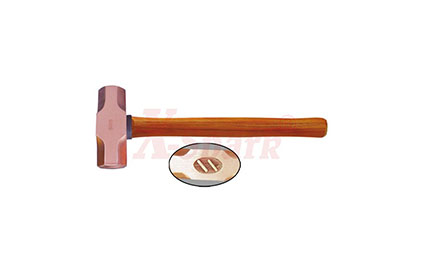After using the explosion-proof hammer, properly maintaining it plays a very important role in the life of the tool:
1)Always store the explosion-proof hammer in a dry place.
2)In our daily work, after 20 consecutive hits, the surface attachments of the hammering explosion-proof hammer should be treated in time, and then used after cleaning. Do not use it continuously, so as not to be hit for a long time. Friction will heat the tool.
3)After using the explosion-proof hammer, wipe off the dirt and deposits on the surface, and then store it in a dry place.
4)Percussion tools, such as explosion-proof copper hammers, percussion wrenches, etc., cannot be hit continuously. There should be a suitable interval for more than ten times. At the same time, the debris adhered to the product must be removed in time before continuing to use. Containing other metal hard particles, it may cause sparks when hammered again and cause an explosion.
5)Cutting edge tools should be placed in the sink and gently touch the grinding wheel for sharpening. Do not use excessive force and contact the grinding wheel for too long.
6)Clean the surface oil stains before using various products, and remember to use the explosion-proof hammer correctly according to the instructions.
Precautions for using explosion-proof tools
1)Percussion tool products, the surface attachment of the tool should be treated after 20 consecutive taps in daily work, and then used after cleaning. Do not use continuously, so as not to cause the tool to be in friction for a long time Heated.
2)Wrench products should not be used excessively, and should not be used to extend the moment arm with a casing or binding other metal rods and to use a hammer to knock (except for the knocking of a wrench) to turn fasteners.
3)After use, clean the dirt and deposits on the surface and store it in a dry and safe place.
4)Cutting edge tools should be placed in the sink and lightly touch the grinding wheel for sharpening. Do not use excessive force and contact the grinding wheel for too long.
Explosion-proof mechanism of explosion-proof tools
Ordinary tool materials are usually made of steel materials. Sparks will be generated due to friction and impact during use. The main reason is that steel materials contain more carbon (in order to increase their strength and hardness). The heat cannot be absorbed and conducted in time, and when the heat is concentrated on the tiny metal particles produced during use, sparks will be generated. Therefore, these tools cannot be used in explosion-dangerous places.

The tools used in explosion-hazardous places must be made of special materials that do not produce frictional sparks, impact sparks, or even hot, high-temperature surfaces. Such tools are called explosion-proof tools. The main material of explosion-proof tools is copper. Copper contains almost no carbon and has very good thermal conductivity. Due to its soft material, when friction or impact occurs, the contact point will be plastically deformed to avoid excessive energy concentration and rapid heat generation. Disperse and reduce the risk of intense heat. However, the strength and hardness of pure copper are too low to be directly used as tools. It is necessary to add appropriate metal elements such as aluminum, titanium, beryllium, nickel, etc. to melt into a copper alloy to improve its strength and hardness.
评论
发表评论